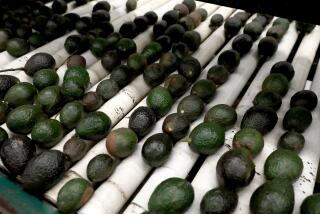Bolivia Weeding Out Its Coca Trade
- Share via
CHIMORE, Bolivia — Claudio Beltran used to grow coca plants, but now he oversees dozens of other Quechua Indian farmers as they pick and process bananas for export.
He’s happy with the changes brought by a government campaign to wipe out production of the raw material for cocaine, and not only because he makes more money.
“The situation in the region is much more peaceful since coca farming disappeared,” he said.
In the 1980s, the Chapare region around Chimore was a no-man’s land where cocaine gangs and coca-leaf farming unions held sway over as many as 250,000 people who depended on the trade for their livelihoods.
But in recent years, the Bolivian government has campaigned aggressively to convert the region’s coca leaf plantations to other crops, first with financial incentives for farmers and lately with the coercive power of the army.
Beltran came to Chapare, a lush tropical region in the heart of Bolivia, in 1982 during the heyday of coca leaf cultivation and cocaine production. He became a coca grower.
Today, he works for Chapare Export, a pioneering banana company that exemplifies the new, coca-free Chapare nurtured by President Hugo Banzer’s government.
Banzer has vowed to get all of Bolivia out of illegal coca leaf growing and cocaine production before his five-year term ends in 2002.
The government says its agents have destroyed at least half the estimated 100,000 acres of coca grown in Chapare since Banzer took office two years ago. A record 35,000 acres of the crop was eradicated last year.
At first, the government paid farming communities $1,000 for every acre of coca they voluntarily destroyed. But now, with soldiers and police presiding over the campaign, coca plantations and nurseries are being cut down without compensation.
Some farmers are known to have moved their coca fields deeper into the forests and away from roads and airfields used by authorities.
Others, however, are accepting the government’s policy--and discovering some advantages.
“We realize we have no choice but to get out of coca farming and find other sources of income,” said Seferino Yucra, 37.
He now earns the equivalent of $150 a month harvesting bananas, compared with $100 from growing coca. And, he adds, he no longer risks arrest or harassment by anti-drug police.
The U.S. government and the United Nations are investing tens of millions of dollars in the development of alternative crops to replace coca and fight the illegal-drug industry.
Miguel Zambrana, owner of Chapare Export, began experimenting with banana plantations nine years ago, backed by $500,000 in seed money provided by the U.S. Agency for International Development.
Assisted by Ecuadorean agricultural experts and additional loans from the World Bank-financed Bolivian Export Foundation, Zambrana has built up a highly successful operation. He employs 200 men and women, most of them former coca leaf growers, and produces bananas for the Argentine and Uruguayan markets.
While preparing the fields, he found the remains of dozens of cocaine paste maceration pits that were only a few hundred yards from the highway that crosses Chapare, the main road linking eastern and western Bolivia.
The most successful crops in Chapare are bananas and hearts of palm. Breaking into the markets in neighboring countries for pineapples, tomatoes, watermelon and other perishable crops has not been as easy.
Private investors are beginning to move into Chapare, too, attracted by the agriculture changes and a growing tourism business.
Increasing numbers of tourists from Bolivia and other countries are visiting Chapare for its diverse wildlife and scenery and modern hotels are going up across the region.
“Driving through the Chapare today evokes images of eco-tourism, tropical fruits and wildlife and moneymaking ventures, images every day more powerful than the region’s past association with the seediness of drug trafficking,” U.S. Ambassador Donna Hrinak said after visiting the area.
More to Read
Sign up for Essential California
The most important California stories and recommendations in your inbox every morning.
You may occasionally receive promotional content from the Los Angeles Times.













